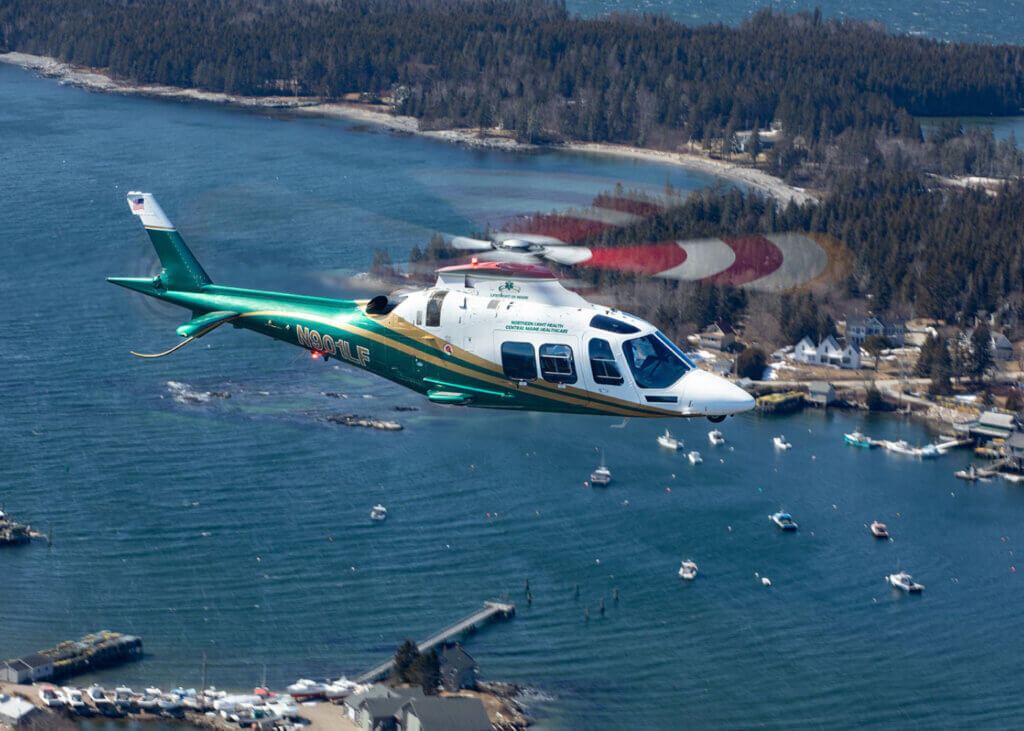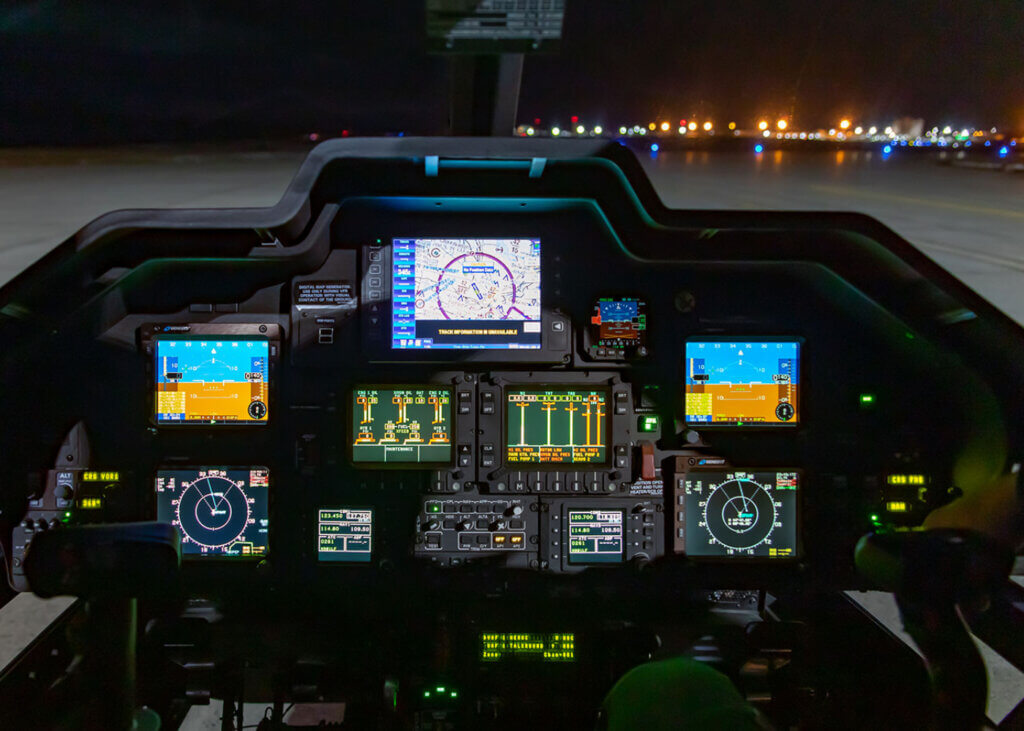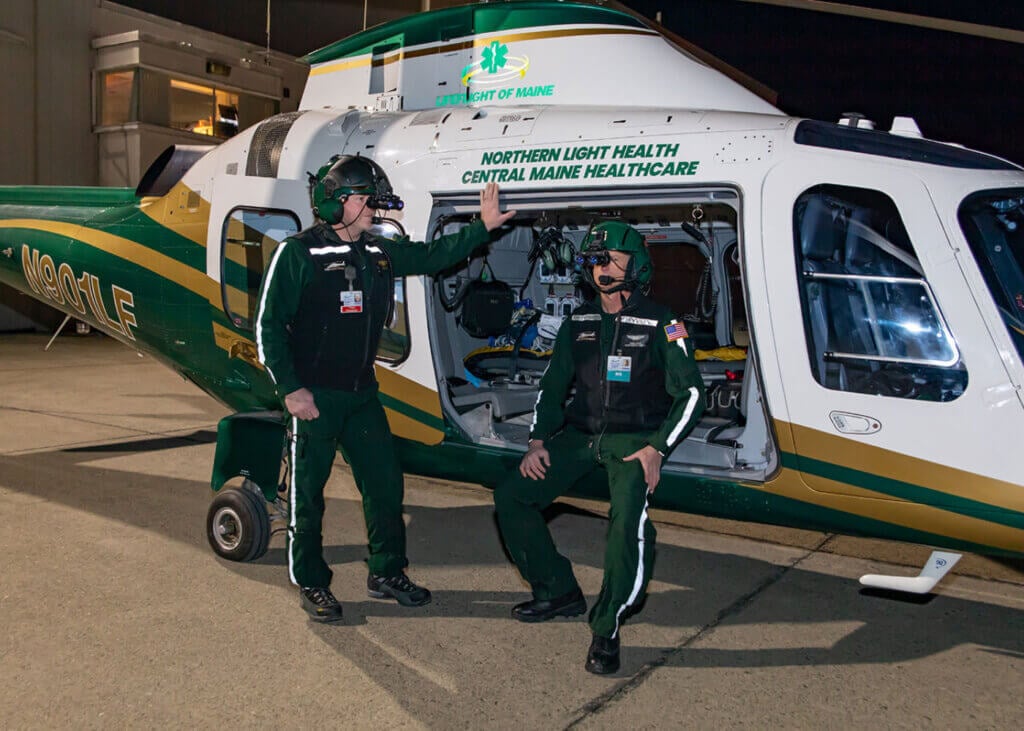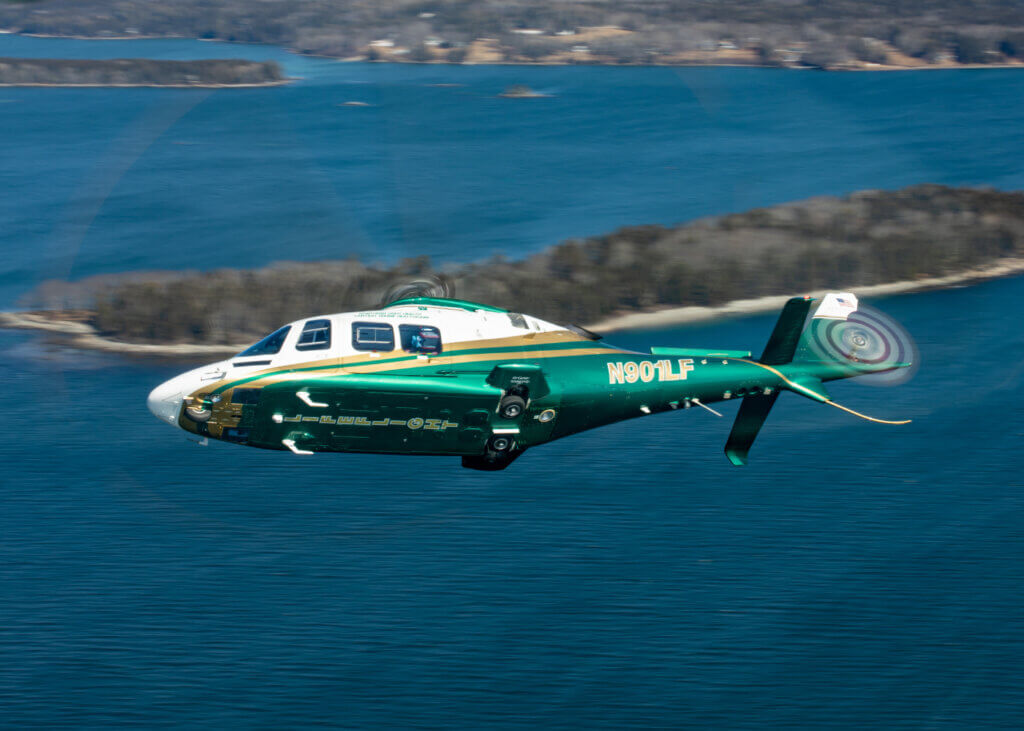It has been a rough decade for rural hospitals across the U.S. Since 2012, more than 130 of the nation’s rural hospitals have closed completely or ceased to provide inpatient services. The Center for Healthcare Quality and Payment Reform estimates that another 600 rural hospitals are now at risk of closure, due to persistent financial losses on patient services and low financial reserves.

Maine is no exception. Almost two-thirds of Maine’s residents live in rural areas, and only three cities in the state have populations greater than 30,000. Three of Maine’s rural hospitals stopped providing inpatient services over the past decade, and five more are seen to be at immediate risk of closure.
As local healthcare options have dwindled, Maine’s rural residents have become increasingly reliant on the state’s only air medical provider, LifeFlight of Maine. Now operating a fleet of three Leonardo AW109SP helicopters with two AW109E maintenance spares and a Beechcraft King Air B200 airplane, LifeFlight provides a critical link between remote communities and the medical services that are only available in larger cities.
“If geography is destiny, should geography make you a second-class citizen in your health outcome?” posed the program’s executive director, Tom Judge. LifeFlight’s answer is no, it should not.
“We’re trying to give everybody that same chance, to the best we can,” he said. “But it doesn’t matter how good the medicine is and it doesn’t matter how good the aviation is, unless you find a way to glue it together.” Gluing it together is what LifeFlight has been striving to do for almost 25 years.

Starting from scratch
Maine is not an easy place to fly. Winters can be brutally cold and extreme temperature swings are common in the spring and fall. During the summer, warm air flowing north from the Gulf Stream encounters cold branches of the Labrador Current just off the coast, creating dense walls of fog that form rapidly and without much warning. Nearly 90 percent of the state is covered by forests, which offer little in the way of forced landing areas.
When LifeFlight was established as a nonprofit organization in 1998, Maine had no other dedicated medical helicopters and not much else to work with: no helipads at the major trauma centers or hospitals, few weather reporting stations, no statewide communication system, and limited fuel availability away from the largest airports. By necessity, LifeFlight had to build not just a program but an entire air medical system from scratch.
“From the very beginning, I took it that one of my jobs was to build an environment that you can operate safely in,” Judge said, emphasizing that air medicine is among the most complex of aviation endeavors with a relentless flow of unscheduled flight requests. “Every one of these questions from the very beginning was: How can we make it safer? And how can we make it more reliable?”
That journey started by addressing the most pressing needs, the ones that would enable safe and effective operations under visual flight rules (VFR). Leveraging state bond funding, LifeFlight facilitated the construction of 32 hospital helipads and installed a radio communications network and 18 automated weather observation stations (AWOS) across Maine. It helped small airports add or upgrade fueling infrastructure so that its helicopters could complete the long round trips required to access patients in remote parts of the state.

Yet, it was always the program’s plan to transition to instrument flight rules (IFR), which Judge saw as crucial to enhancing both safety and reliability — the ability of the program to deliver care even when clouds or fog ruled out VFR. That drove LifeFlight’s initial selection of the IFR-capable Agusta A109, variants of which it has been flying ever since.
LifeFlight and its aviation vendor at the time, Era Helicopters, launched IFR operations in 2005. (Judge described it as a “strategic safety investment,” complemented by the “tactical safety enhancement” of night vision goggles in 2008.) Concurrently, LifeFlight was funding development of the GPS instrument approach and departure procedures it needed to conduct IFR operations to and from hospitals, islands, and certain small airports. Today, LifeFlight has 38 approach and 25 departure procedures, with another 14 procedures in development.
LifeFlight also funded an early IFR route network, which was in place by 2011, and established predictable routes by which its helicopters could transit the state under IFR. However, these routes were fairly wide, which necessitated minimum en route altitudes of 6,000 to 8,000 feet (1,830 to 2,440 meters) mean sea level to ensure adequate obstacle clearance. The high altitudes combined with Maine’s harsh weather limited the routes’ usefulness for the AW109, which is not certified to fly in known icing conditions.
“Generally, once you’re up above 3,000 ft. [915 m] here, you’re seeing pretty significant temperature changes,” Judge said, explaining why the routes were often unusable not only in the dead of winter, but also in the shoulder seasons. “If you can stay below, certainly 5,000 ft. [1,525 m], but even below 3,000 ft. [915 m] or so, you have a much better chance of staying out of [icing conditions].”

Next-gen navigation
Fortunately, there was a solution for LifeFlight’s problem: performance-based navigation (PBN). The PBN concept incorporates both area navigation (RNAV) — the ability of an aircraft to navigate on any desired flight path — and required navigation performance (RNP), which involves onboard performance monitoring and alerting, supported by satellite-based navigation. Together, they allow an aircraft to follow a specified flight path with a high degree of precision. That enables IFR routes to be narrower, meaning they can avoid obstacles and terrain that would otherwise require higher clearance altitudes.
The Federal Aviation Administration (FAA) has established RNP 0.3 as the PBN standard for rotorcraft. This specifies that a helicopter be able to stay within 0.3 nautical miles (0.5 kilometers) laterally along a track for at least 95 percent of the total flight time. Whereas standard airways are 8 nm (14.8 km) wide, an RNP 0.3 route can be just 1.8 nm (3.3 km) across, consisting of a 0.6 nm (1.1 km) primary area and a 0.3 nm (0.5 km) secondary area on either side of the centerline.
LifeFlight was early in recognizing the potential of PBN for helicopter IFR and helped campaign to make it a federal priority. In 2016, the FAA published its PBN NAS (National Airspace System) Navigation Strategy, which identified helicopter IFR routing and PBN approaches as a focus area, with a special emphasis on approaches to hospitals.
The same year, the standards body RTCA established a tactical operations committee to further develop a strategy for PBN. It issued a number of recommendations in 2017, including that the FAA should initiate a demonstration project implementing an RNP 0.3 helicopter route. Acknowledging that the FAA had already completed one RNP 0.3 demonstration project that spring in partnership with the Maryland State Police and the Potomac TRACON, the committee said this initial project “should be expanded and the lessons learned [and best practices] be leveraged for future helicopter route development.”

In 2019, Senator Susan Collins of Maine spearheaded the first of several $5 million appropriations to launch a demonstration project with LifeFlight due to the nature of its lifesaving services and statewide infrastructure to support low-altitude IFR. Compared to more congested airspace, Maine also had the advantage of being relatively quiet and out of the way, giving the FAA breathing room as it sought to develop its own capabilities and replicable processes.
The FAA launched the project in early 2020 on the eve of the COVID-19 pandemic. Although work has not proceeded swiftly, the first RNP 0.3 route, ZK362, is now complete, with six more primary routes and 17 sub-routes in development. All of LifeFlight’s existing approach and departure procedures are also being revised to connect more efficiently to the new routes, which have minimum en route altitudes below 3,000 ft. (915 m). The first routes will enable seamless IFR operations between 21 hospitals and 17 airports from the far reaches of northern Maine to the New Hampshire border, covering around 80 percent of the state’s population. Routes into the western mountains will be the next step.
According to Dave Burr, LifeFlight’s director of aviation operations, the new system will make helicopter IFR operations safer and more predictable, not only for flight crews but also for air traffic control. “It’s better for everybody,” he said. “We’re proving that it works.”
To make it work, however, LifeFlight had to upgrade to helicopters capable of meeting the RNP 0.3 performance standard. In 2016, it launched a five-year, $20 million capital campaign that supported the acquisition of three new AW109SP helicopters, which feature enhanced avionics and four-axis autopilots. They replaced LifeFlight’s previous AW109E helicopters in 2020, 2021, and December 2022, respectively.

Growing capabilities
LifeFlight achieved another milestone in 2022: completing the transition to its own FAA part 135 operating certificate. “Doing our own 135 was a big leap forward, because not only are you getting that local knowledge, you’re tailoring your certificate to your area,” said Josh Dickson, who joined LifeFlight in 2007 and is now director of aviation services. “So, if you were to take our GOM [general operations manual], it’s written for Maine, it has examples for Maine and is tailored for this operation.”
Bringing aviation in-house also reinforced LifeFlight’s commitment to IFR operations, which Dickson said the program is doing more of than ever before. Pilots are now encouraged to file and fly IFR as often as possible, not just when weather conditions demand it.
“By the repetition of doing it, not only are they maintaining proficiency, but if the weather gets bad, they’re already on an IFR flight plan, or they at least have one on file,” he said. “The other advantage that people don’t talk about is it’s actually good for the controllers, too, because they also need the exercise of pulling up our lesser-used PinS [point-in-space] approaches.”
Meanwhile, LifeFlight continues to invest in other aviation infrastructure throughout the state: adding more remote fuel depots, replacing AWOS installations, and extending runways at rural airports. Notably, it is now in the process of installing a statewide network of remotely controlled weather cameras, supported by a grant from the Maine Emergency Management Agency. By the end of 2022, LifeFlight had installed 15 of a planned 35 weather cams.
“We’re doing two things,” explained LifeFlight’s infrastructure engineer, John Rolfson, who is also responsible for maintaining the program’s statewide AWOS and radio communications networks. “The first is, our dispatchers and our pilots here are going to have the ability to pull up these cameras on a live viewing platform and see real-time video. So that’s a piece of it. And then the second part is, how do you benefit the general aviation community? How do you get it out there for everybody to use?”
For that, LifeFlight has partnered with the FAA to make its camera feeds available on the agency’s WeatherCams website, helping to gradually populate its still mostly blank map of the contiguous U.S. with real-time imagery of actual weather conditions. The first of LifeFlight’s camera feeds were online and available to the public by the end of the year.

Gluing it all together
For LifeFlight, its investments in aircraft and infrastructure aren’t simply a way to make its aviation operations safer and more effective — they’re essential to its medical mission, too.
“We don’t look at airports as just airports — we look at them as healthcare access points,” said Dickson, noting that their significance has only grown as rural hospitals have closed or cut back on services. Small communities may not have the population to support a cath lab or a neonatal intensive care unit, he said, and “some places lack a hospital or even a clinic in their area. But we can work with a community to extend a runway and add a couple of instrument approaches,” which then becomes a way to “plug that hole” in the healthcare system. These investments can create a more sustainable model by which to deliver rural healthcare in some scenarios, he suggested.
Judge predicted that a fully developed IFR system will incrementally improve LifeFlight’s reliability by six percent to eight percent, which he acknowledged doesn’t sound like a lot on the face of it. “But that’s a couple hundred people a year,” he said. “And for those 150 or 200 people, that’s actually really important for them, because for some of those people, it’s life or death.”





